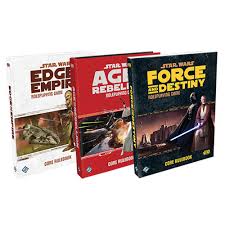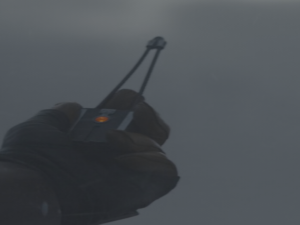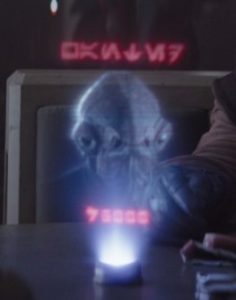
The new live-action series The Mandalorian has given fans many new insights into the Star Wars universe especially in regards to the bounty hunting profession and how technology is used to track beings. I am speaking, of course, about tracking fobs which seem to use a chain code from an individual to track them down. Every indication is that the chain code likely has something to do with the genetic code of the individual and is personally identifying right down to the target’s age. Once the bounty hunter has a tracking fob and the target’s last known location then they can get to work capturing their quarry.
This is not the first time that Star Wars lore has used genetic signatures to track targets. A creature or bio-technical device called a Bio-Hound was introduced in the West End Games version of the Star Wars RPG. These devices were used by the Empire to track wanted beings using hair, skin, or other biological markers and were limited in range, generally, to the last known location of the target. Bio-Hounds, once they found their target, could mark them with a clear and odorless tracer compound to lead Imperial forces to them or assassinate them with an acidic poison.
What follows are game statistics for the FFG Star Wars system to incorporate tracking fobs, bounty pucks, and Imperial Bio-Hounds into your campaign.
Tracking Fob 
Encoded with its target’s unique genetic chain code, a tracking fob is typically issued to bounty hunters along with their bounty puck, or contract, to aid in their efforts to apprehend the correct target. When using a tracking fob to track a unique target, all die rolls related to finding the target gain a boost die as long as the target is still within the same hemisphere as the tracking fob. This includes opposed rolls against hiding or obscured targets when the fob is being actively used. Unless it is reprogrammed a bounty tracking fob retains information about its last programmed target so that, in the event of an escape, the fob can be remotely reactivated and resume active tracking of the target.
Without a genetic sample of hair, scales, skin cells, blood, or other bodily fluids or excretions, a bounty tracking fob can not be programmed with a complete chain code. Having an incomplete chain code, such as only knowing the target’s age or species, causes the user of a tracking fob to add one setback die to any die rolls related to finding the target if other living beings of the same age or species are between the target and the tracking fob. For example, a bounty hunter using a fob with an incomplete chain code may know a target is in a given building or compound, but until the hunter gets closer to the target or eliminates false readings he will not be able to fully benefit from the fob’s utility.
Genetic data is typically collected from beings who are incarcerated, released through a bail bondsman, or involved with taking loans from underworld sources. Blood or other evidence left at the scene of a crime can also be collected and programmed into a tracking fob though most law enforcement agencies are hesitant to use what could be considered circumstantial evidence to track an alleged criminal. Tracking fobs and bounty pucks are therefore issued together for most legitimately posted bounties.
Price: 50 credits Encum: 0 Rarity: 3
Bounty Puck
The bounty puck is a flat, palm-sized, round memory device with a holographic display for recording the details of a bounty contract. Details will typically include payment conditions, warrant information, personal data including genetic chain code, and an image of the target. They are usually issued to a bounty hunter along with a tracking fob if the required genetic information is available. They are reusable and each puck can only be programmed with information on one target.
Price: 50 credits Encum: 0 Rarity: 2
Imperial Bio-Hound
Approximately one meter long and roughly the size and shape of a terrestrial snake, an Imperial Bio-Hound is a living organism supplemented by a biological computer to track and either mark, or assassinate, its target. The Bio-Hound can be released into an urban or wilderness environment in most climates and will track its programmed target with single-minded determination. Covered in mottled gray flexi-skin and lacking a rigid skeleton, it can pull itself into a lumpy ball or squeeze through a grate in pursuit of its quarry. Semi-intelligent and patient, it is able to display great cunning as it hides in a bag or rolls up a ship’s ramp to get closer to its target.
The Empire will usually release a Bio-Hound after a target when it has collected genetic material of the being and expects that they are still on the same planet. Depending on the mission parameters and value of the target, the Bio-Hound will usually engage its target and secrete a Heldrium-Bastelt chemical tracer compound that is a clear and odorless liquid. Some Bio-Hounds are also modified to carry five doses of an acidic poison that they will attempt to inject into their target to eliminate it. At the same time, the Bio-Hound will transmit a locator signal enabling Imperial agents to lock onto its position and begin tracking it at a range of up to 50,000 kilometers. Once in range, agents can also track the tracer compound though at a much closer distance of one kilometer or less.
Imperial Bio-Hound
Beast [Rival]
Characteristics
Brawn 2
Agility 2
Intellect 1
Cunning 4
Presence 1
Willpower 1
Soak: 2 Wound Threshold: 5 Defense (m/r): 0/0
Skills: Brawl 3, Perception 3, Stealth 1, Survival 2, Vigilance 2
Talents: None
Abilities: Silhouette 0
Equipment: Tracer Compound (Brawl, Damage 1, Critical -, Engaged range, marked target may be tracked with an Easy difficulty Perception check when using the tracking receiver and within a range of 1 km), Acidic Poison (Brawl, Damage 5, Critical 3, Engaged range, Pierce 1, Limited Ammo 5)
Latest posts by Brian Wilson (see all)
- Campaign HQ – Going Out With A Bang…or a Whistling Bird…At Least - April 14, 2020
